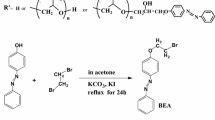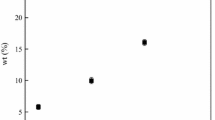Abstract
(Hydroxypropyl)cellulose (HPC) derivatives with butyryl (Bu) and heptafluorobutyryl (7FBu) substituents were prepared in various proportions of the Bu/7FBu groups and at a fixed total DS (DSBu + DS7FBu) of 3.0. Thermotropic liquid crystallinity of the derivatives (Bu7FBu-HPC) was investigated to specify the effect of the fluoroacylation on the mesophase behavior. Thermal transition data were collected using differential scanning calorimetry and polarized light microscopy. The Bu7FBu-HPC samples formed a chiral nematic phase between their glass transition and isotropization temperatures, Tg and Ti-a, respectively; these transition temperatures rose moderately as the 7FBu proportion increased (Tg = − 44 to − 27 °C and Ti-a = 158–190 °C for DS7FBu = 0.04–1.60). The structural property of the mesophase was examined at 70 °C by circular dichroism and other optical measurements. The chiral nematic pitch (P) sensitively increased with increasing 7FBu proportion, while the supramolecular helical arrangement remained right-handed. Selective light-reflection colors were observed for the samples of DS7FBu = 0.04–0.8, covering an entire spectrum range from violet to red. Temperature dependence of P was also examined for selected samples below Ti-a, and it was found to increase with increasing temperature; however, there was no indication of inversion in the handedness of the helical structure. Wide-angle X-ray diffractometry revealed that the increases of P responding to the increases in DS7FBu and temperature were attributable to the decrease of the twist angle between adjacent thin nematic layers.
Graphical abstract












Similar content being viewed by others
References
de Vries H (1951) Rotatory power and other optical properties of certain liquid crystals. Acta Crystallogr 4:219–226
Fukuda T, Takada A, Miyamoto T (1994) Thermotropic cellulose derivatives. In: Gilbert RD (ed) Cellulosic polymers, blends and composites (Chapter 3). Hanser, Munich, pp 47–70
Fukuda T, Tsujii Y, Miyamoto T (1995) Structural characteristics of polysaccharide-based thermotropic liquid crystals. Macromol Symp 99:257–267
Gilbert RD, Patton PA (1983) Liquid crystal formation in cellulose and cellulose derivatives. Prog Polym Sci 9:115–131
Gray DG (1983) Liquid crystalline cellulose derivatives. J Appl Polym Sci: Appl Polym Symp 37:179–192
Gray DG (1985) Chemical characteristics of cellulosic liquid crystals. Faraday Discuss Chem Soc 79:257–264
Gray DG (1994) Chiral nematic ordering of polysaccharides. Carbohydr Polym 25:277–284
Gray DG, Harkness BR (1994) Chiral nematic mesophases of lyoptropic and thermotropic cellulose derivatives. In: Shibaev VP, Lam L (eds) Liquid crystalline and mesomorphic polymers. Springer, New York, pp 298–323
Guittard F, Yamagishi T, Cambon A, Sixou P (1994) Preparation and liquid crystalline properties of (hydroxypropyl)cellulose perfluorooctanoate. Macromolecules 27:6988–6990
Guo J-X, Gray DG (1994) Lyotropic cellulosic liquid crystals. In: Gilbert RD (ed) Cellulosic polymers, blends and composites (Chapter 2). Hanser, Munich, pp 25–45
Hasegawa T (2015) Understanding of the intrinsic difference between normal- and perfluoro-alkyl compounds toward total understanding of material properties. Chem Phys Lett 627:64–66
Hasegawa T (2017) Physicochemical nature of perfluoroalkyl compounds induced by fluorine. Chem Rec 17:903–917
Ho FF-L, Kohler RR, Ward GA (1972) Determination of molar substitution and degree of substitution of hydroxypropyl cellulose by nuclear magnetic resonance spectroscopy. Anal Chem 44:178–181
Hou H, Reuning A, Wendorff JH, Greiner A (2000) Tuning of the pitch height of thermotropic cellulose esters. Macromol Chem Phys 201:2050–2054
Huang B, Ge JJ, Li Y, Hou H (2007) Aliphatic acid esters of (2-hydroxypropyl) cellulose—Effect of side chain length on properties of cholesteric liquid crystals. Polymer 48:264–269
Ishizaki T, Uemura S, Furumi S (2015) Thermotropic properties of cholesteric liquid crystal from hydroxypropyl cellulose mixed esters. Kobunshi Ronbunshu 72:737–745
Kosho H, Hiramatsu S, Nishi T, Tanaka Y, Kawaguchi S, Watanabe J (1999) Thermotropic cholesteric liquid crystals in ester derivatives of hydroxypropylcellulose. High Perform Polym 11:41–48
Laivins GV, Gray DG (1985) Optical properties of (acetoxypropyl)cellulose: factors influencing the cholesteric pitch. Polymer 26:1435–1442
Lee D, Perlin AS (1982) 13C-N.M.R.-spectral of substituents and related studies on the distribution in O-(2-hydroxypropyl)cellulose. Carbohydr Res 106:1–19
Nishio Y (2006) Material functionalization of cellulose and related polysaccharides via diverse microcompositions. Adv Polym Sci 205:97–151
Nishio Y, Sato J, Sugimura K (2016) Liquid crystals of cellulosics: fascinating ordered structures for the design of functional material systems. Adv Polym Sci 271:241–286
Ohlendorf P, Greiner A (2015) Synthesis of liquid crystalline thioether-functionalized hydroxypropyl cellulose esters. Polym Chem 6:2734–2739
Ritcey AM, Gray DG (1988) Circular reflectivity from the cholesteric liquid crystalline phase of (2-ethoxypropyl)cellulose. Macromolecules 21:1251–1255
Tseng S-L, Valente A, Gray DG (1981) Cholesteric liquid crystalline phases based on (acetoxypropyl)cellulose. Macromolecules 14:715–719
Werbowyj RS, Gray DG (1976) Liquid crystalline structure in aqueous hydroxypropyl cellulose solutions. Mol Cryst Liq Cryst (Lett) 34:97–103
Werbowyj RS, Gray DG (1980) Ordered phase formation in concentrated hydroxypropyl cellulose solutions. Macromolecules 13:69–73
Yamagishi T, Guittard F, Godinho MH, Martins AF, Cambon A, Sixou P (1994) Comparison of thermal and cholesteric mesophase properties among the three kind of hydroxypropylcellulose (HPC) derivatives. Polym Bull 32:47–54
Yamagishi T, Nakamoto Y, Sixou P (2006) Preparation and cholesteric mesophase properties of (butyl-co-pentyl) propylcellulose. Cellulose 13:205–211
Zugenmaier P (1994) Polymer solvent interaction in lyotropic liquid crystalline cellulose derivative systems. In: Gilbert RD (ed) Cellulosic polymers, blends and composites (Chapter 4). Hanser, Munich, pp 71–94
Zugenmaier P (1998) Cellulosic liquid crystals. In: Demus D, Goodby J, Gray GW, Spiess H-W, Vill V (eds) Handbook of liquid crystals, vol 3. Chapter IX, Wiley-VCH, Weinheim, pp 453–482
Acknowledgments
This work was financed by Grant-in-Aids (KAKENHI) for Scientific Research (A) (No. 26252025 to YN) and Young Scientist Research (B) (No. 17K15295 to KS) from the Japan Society for the Promotion of Science (JSPS).
Author information
Authors and Affiliations
Corresponding author
Ethics declarations
Conflict of interest
The authors declare no conflict of interest.
Electronic supplementary material
Below is the link to the electronic supplementary material.
Rights and permissions
About this article
Cite this article
Ishii, H., Sugimura, K. & Nishio, Y. Thermotropic liquid crystalline properties of (hydroxypropyl)cellulose derivatives with butyryl and heptafluorobutyryl substituents. Cellulose 26, 399–412 (2019). https://doi.org/10.1007/s10570-018-2176-6
Received:
Accepted:
Published:
Issue Date:
DOI: https://doi.org/10.1007/s10570-018-2176-6




